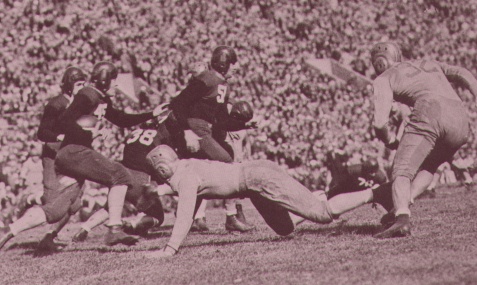1ST TEAM ALL-AMERICAN Biggie Munn, G, 1931 Butch Larson, E, 1933-1934 Pug Lund, HB, 1934 Bill Bevan, G, 1934 Bud Wilkinson, G, 1935 Ed Widseth, T, 1935-1936 Dick Smith, T, 1935 Ray King, E, 1937 Andy Uram, FB, 1937 Francis Twedell, G, 1938 1ST TEAM ALL-BIG TEN Sheldon Beise, FB, 1935 Phil Bengston, T, 1934 Bill Bevan, G, 1934 Rudy Gmitro, HB, 1937 Ray King, E, 1937 Butch Larson, E, 1933-1934 Babe LeVoir, QB, 1935 Pug Lund, HB, 1933-1934 Jack Manders, FB, 1931 Lou Midler, T, 1937 Wilbur Moore, QB, 1938 Biggie Munn, G, 1930-1931 Win Pederson, T, 1939 Dick Smith, T, 1935 Bob Tenner, E, 1934 Francis Twedell, G, 1937-1938 Andy Uram, HB, 1936 Marshall Wells, T, 1932 Ed Widseth, T, 1934-1936 Bud Wilkinson, G, 1935 GOPHER HEAD COACHES Fritz Crisler, 1930-1931 Bernie Bierman, 1932-1939
1930's Gopher Links
Gopher Scores, 1921-1940:1934 National Championship:
1935 National Championship:
1936 National Championship:

The departure of Spears brought the hiring of Fritz Crisler. Crisler would stay at Minnesota just two seasons before moving on the greater success at Princeton and Michigan. Crisler's best player was lineman Clarence 'Biggie' Munn, who himself would become a superb head coach at Michigan State after World War II. To replace Crisler, the Gophers hired Bernie Bierman. The former football and track star from the Williams era would demand precision and perfection from his Gopher teams. This approach would pay huge dividends. His first Gopher team forged a 5-3 record, but he was incubating a dynasty. 1933 saw the Gophers go 4-0-4, and suddenly his squad could play with anybody. Bierman's Gophers reached a peak in 1934, as his team rolled to an 8-0 mark and the National Championship. Led by left halfback Pug Lund, the Gophers fielded all-stars at virtually every position. So deep were the Gophers that it has been suggested that even their second-string would likely have gone unbeaten. The only team able to come close to the Gophers was Pittsburgh, who succumbed 13-7 in a classic battle that would eventually determine collegiate supremacy. For various reasons, the Gophers lost more talent after the 1934 season than most schools do in a decade. Still, Bierman's coolly-efficient single-wing offense continued to roll. The Gophers again finished 8-0, and were again acclaimed National Champions by most polling organizations. The Gophers' winning streak would finally come to an end in 1936 with an unexpected loss to Northwestern, but they would rally to finish 7-1 and win the National Championship for the third year in a row. Minnesota football was truly on top of the world. The Gophers would win Big Ten titles in both 1937 and 1938 with 6-2 records, which after the previous three years must have seemed like a letdown. They would fall below .500 in 1939, but that season could not detract from what had been a truly "Golden" decade for the Gophers.
